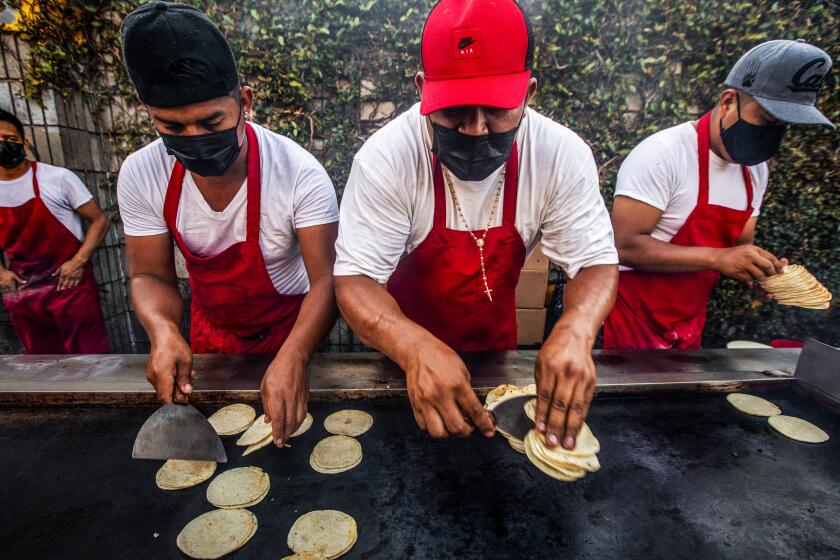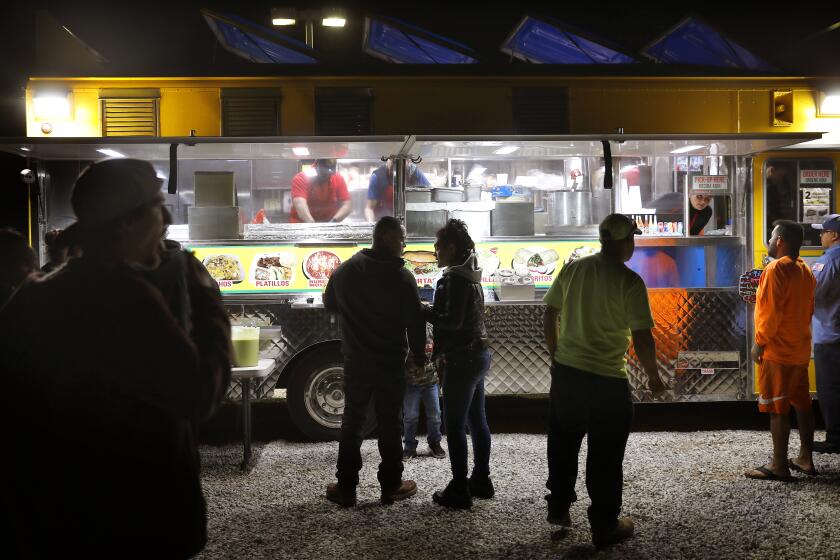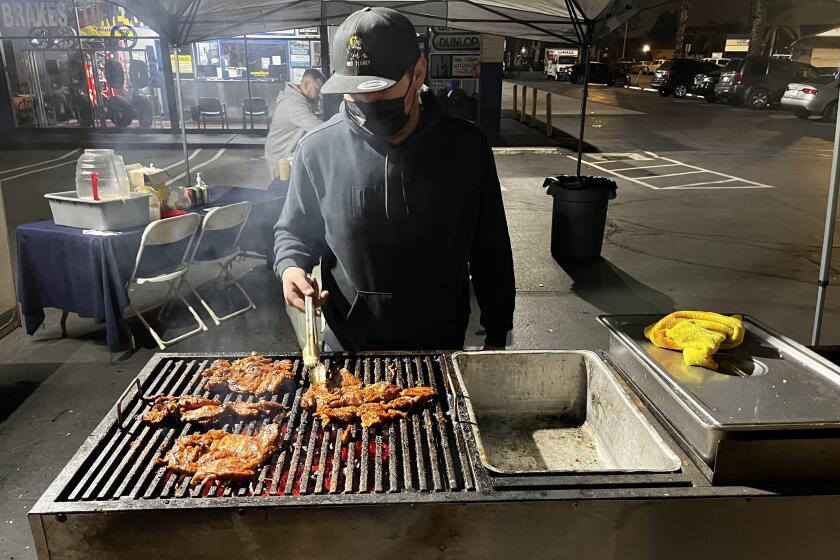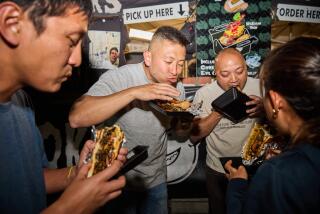Inflation grips L.A. taco vendors: Less meat? Raise prices? Absorb losses?
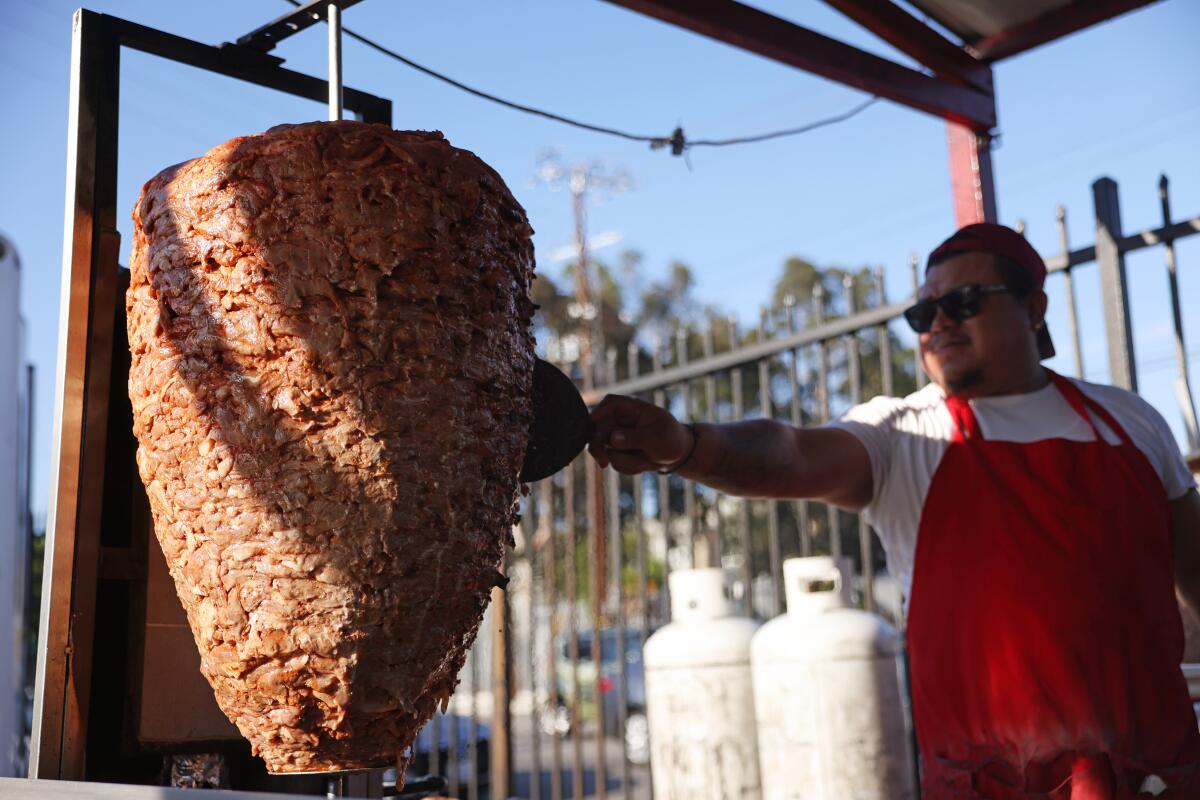
On a recent weeknight, street vendor Reina Orozco was busy flipping store-bought tortillas on a makeshift grill as she prepared carne asada and chicken tacos for sale near MacArthur Park.
Supplies cost more these days, and sometimes Orozco has to cut back on the meat in her $1.50 tacos.
“Prices go up,” said Orozco, 52, from Zacatecas, Mexico, “but that might not matter to hungry people who have money.”
Rising food and fuel costs have forced some street vendors to ration their supplies or raise their prices on what some take for granted as convenient and affordable food. But for many entrepreneurs their livelihood is at stake amid soaring inflation.
From April 2021 to April 2022, prices jumped by 14% for meat, poultry, fish and eggs across the United States, one of the largest increases since 1979, according to the U.S. Bureau of Labor Statistics.
Vegetable and fruit prices also spiked nearly 8% over the last year. The cost of propane, which fuels vendors’ grills, has increased 26% since last year, an average of $3.08 a gallon, according to the personal finance website the Balance.
In the waning light of day, smoke from the Avenue 26 Tacos streetside grill in Little Tokyo wafts through the air, beckoning hungry patrons just getting off work. A bulbous cut of pork crisps on the rotating trompo over an open flame and tortillas are flipped on a Mexican comal.
Erasmo Reyes, 48, and his son, Cesar, 26, watch as several cooks prepare carne asada and tacos al pastor for a steady stream of customers.
The stand first opened on Avenue 26 in Lincoln Heights more than a decade ago. During the pandemic, a bustling night food market sprang up in the area, attracting hordes of foodies, more vendors and eventually problems. The city shut down the night market last year over health and safety concerns.
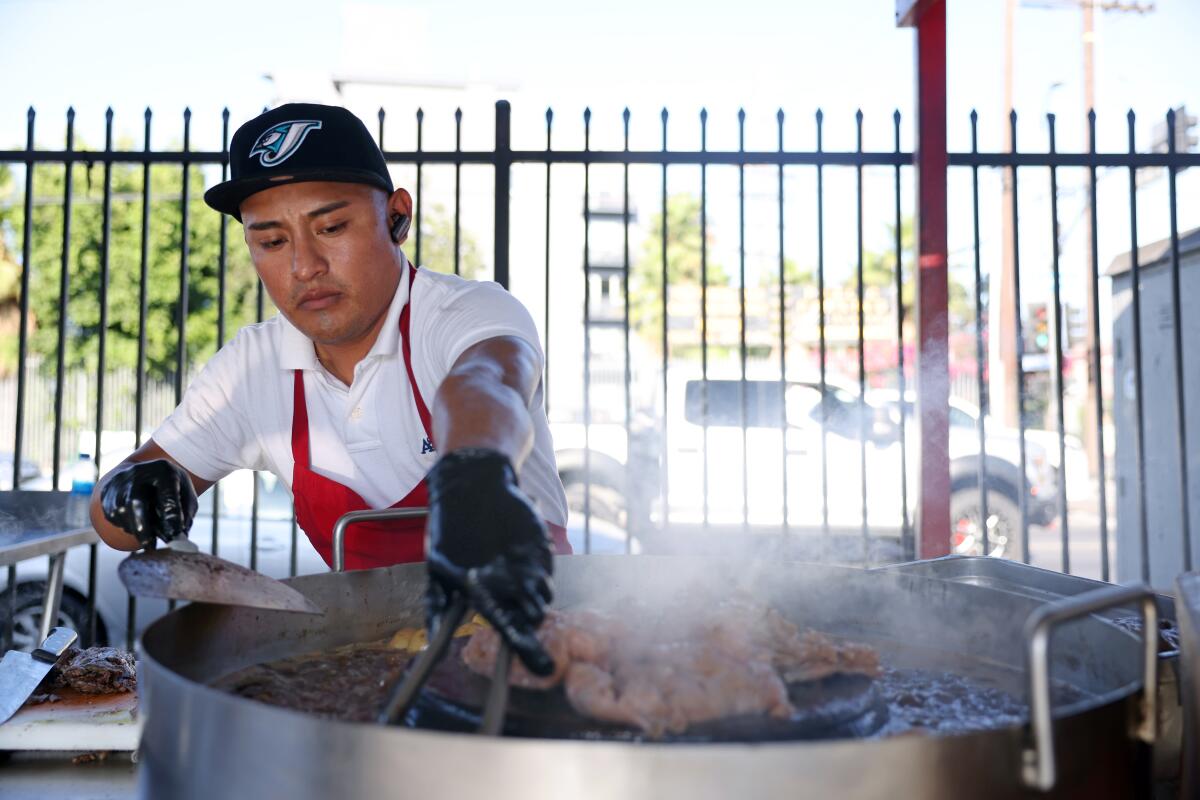
Cesar Reyes started working for his father when he was 14, perfecting the family recipes brought from Puebla, Mexico. When it became clear that their Lincoln Heights location was too crowded, he sought a new location to keep the family business alive.
Over the years, the family has raised the cost of their tacos from 50 cents to the current $1.75. But the Reyes family is always the last to increase prices whenever possible.
“When everyone saw that we were doing well on Avenue 26 they followed us and cooked food like ours. And then they started to raise their prices, but we’ve always made sure that we’re the last ones to raise ours,” Cesar said.
While food prices are skyrocketing, the Reyeses said they also have to consider their loyal patrons.
“We see that, but right now we have to wait and see. We’re not going to raise our prices yet, because we have to think of our customers,” Erasmo said.
“A lot of our customers are low-income people who enjoy our food and can’t always afford to pay more than $2 for a taco,” Cesar Reyes said. “You sometimes have customers argue over prices, but we have to tell them that it’s not our fault. Prices are going up and we will continue to make our food the way customers have always liked. They don’t realize that if we don’t raise our prices now and then, well, we might not be around.”
What was once a handful of small retailers along Avenue 26 in Lincoln Heights has boomed into a full-fledged night market.
Brothers Miguel and Luis Contreras stood with their families in the shade of a school bus parked near the grill stands. Miguel said they spent about $60 on food for about six people and another $20 on sodas.
“Of course we’re aware of inflation,” Miguel said in Spanish. “But you work, you come home tired and you want to eat, so you come to get your food.”
“It can’t be helped. We have to feed our families,” Luis said. “I know gas is expensive and almost $7 in places, but I still have to drive for work.”
The brothers work at a party supply store. They and their families eat at taco stands maybe once a week now, because of the price increase in groceries.
“I don’t pay attention to the price of the taco,” Luis Contreras admits. “Maybe I should, but I don’t. I usually don’t ask.”
The vandalism of Whittier’s Tacos La Guera on Thursday and a competitor’s subsequent arrest highlight the challenges faced by L.A. County street vendors.
The atmosphere in the parking lot has a communal vibe as people tailgate and eat their food. Some play music from their cars, while others simply use their car hoods as table tops.
Kelsey McCoy and Sandra Gao often bring out-of-town visitors to Avenue 26 Tacos.
“They’re probably the best in town,” McCoy said.
“We’re going to keep coming back,” Gao said. “Even if the prices go up a little more. They’re going up everywhere. Even the hotdogs wrapped in bacon that you see outside the Staples Center are so expensive now. Like almost $9.”
On the other end of the parking lot, Karla Perez eats a quesadilla with chorizo and has an al pastor taco on the side.
“Almost like $12 for my quesadilla, it’s like way too much,” Perez said. “The food is good but maybe too much. I don’t want it to be more than if I went to a sit down restaurant.”
Mexican street food has been part of California for over 140 years. Why do officials still harass vendors?
Though some customers might complain about prices, some of the vendors’ allies understand there’s more at stake than just sticker price shock.
“I think that people don’t understand the true cost of food,” Rudy Espinoza, executive director with the nonprofit Inclusive Action for the City. The group advocates on behalf of street vendors and also provides micro-loans and business coaching to would-be entrepreneurs.
“[Customers] may see a street vendor, and they might assume that it’s affordable, or should be affordable. And they may sort of sneer if the price goes up from one week to the next. They may expect the food to just be affordable all the time. And that’s just not real,” Espinoza said.
He does not expect it to get any better anytime soon with the high costs of groceries, fuel and services. He’s hopeful that people realize how much work street vendors must do to prepare their food before they ever hit the streets and fire up their grills.
Since the start of the pandemic, more street vendors have sought micro-loans and other assistance from his group, Espinoza said.
“There’s a lot of folks that are seeking capital for food businesses, especially with food prices going up. They’re struggling to figure out how to pay for all the sort of hard costs, while also making sure that they’re not sort of passing the debts to their customers,” Espinoza said. “But at some point, they, you know, they have to. I think everyone has to contribute to this.”
More to Read
Sign up for Essential California
The most important California stories and recommendations in your inbox every morning.
You may occasionally receive promotional content from the Los Angeles Times.

